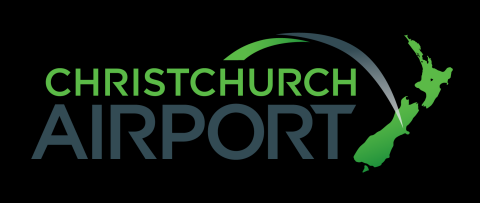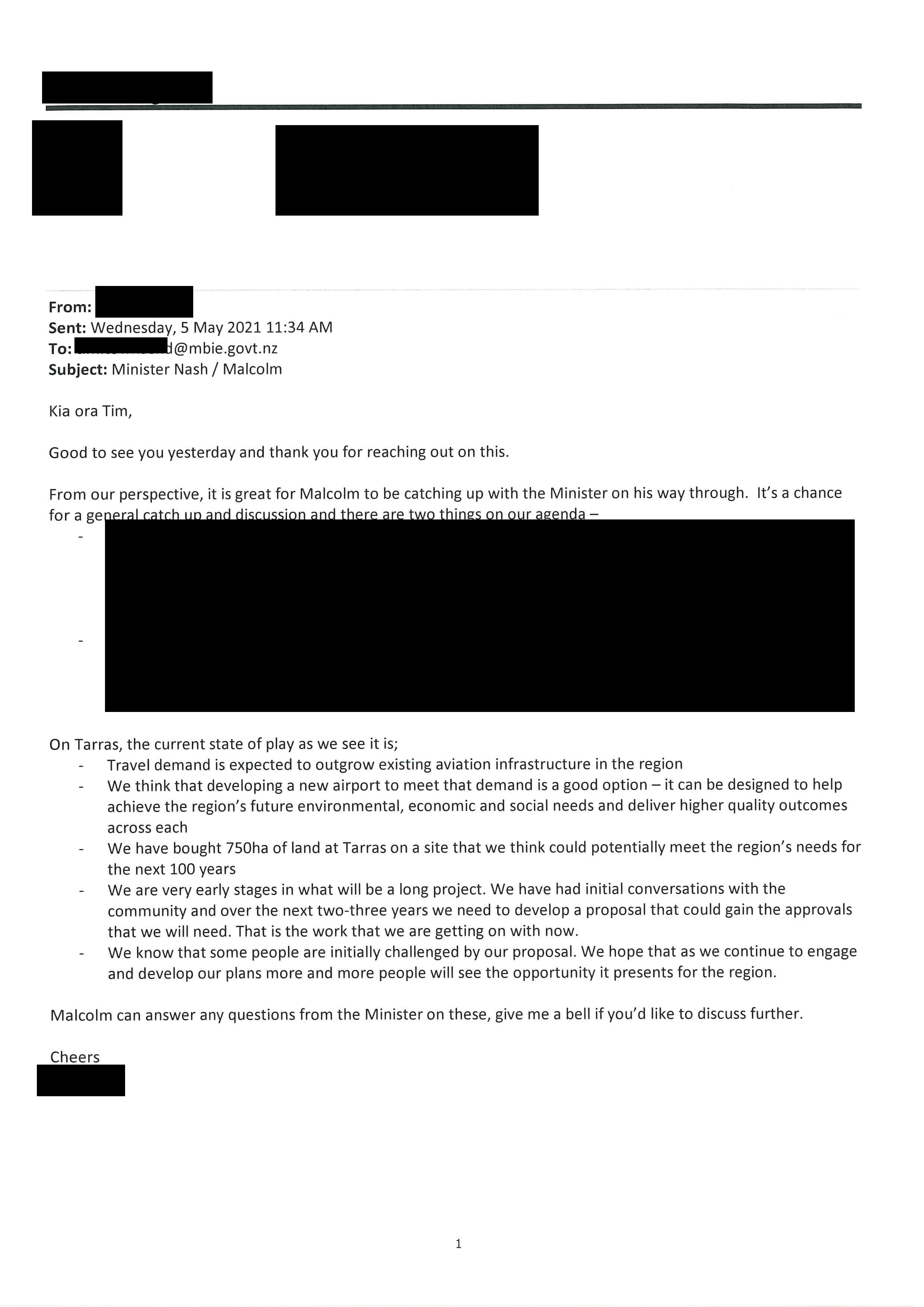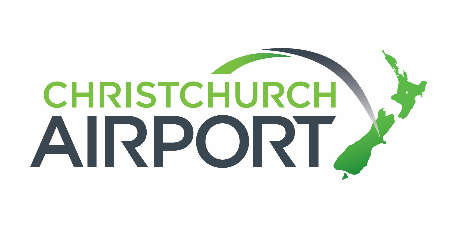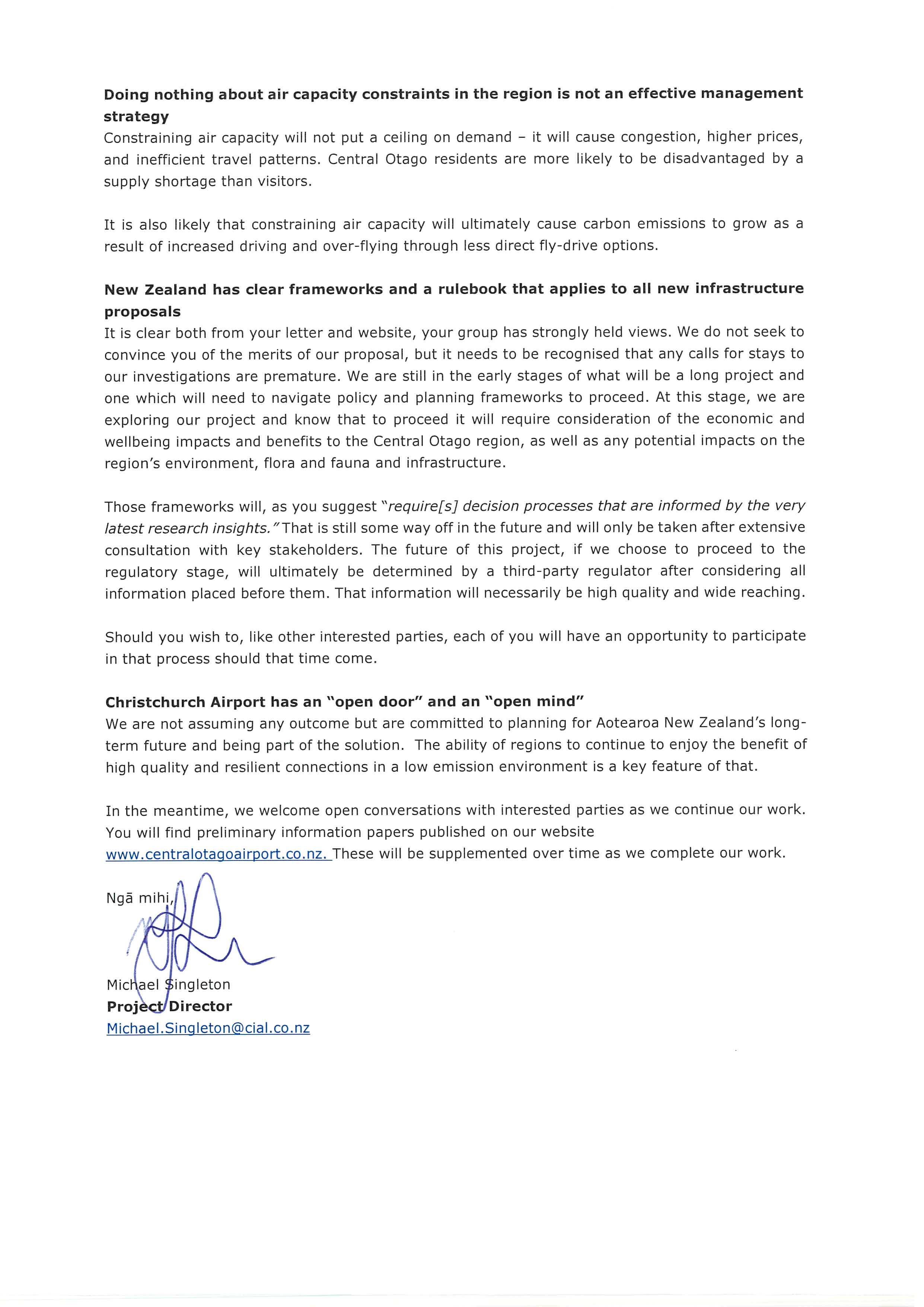
PO Box 14001
Christchurch 8544
New Zealand
Telephone (+64 3) 358 5029
christchurchairport.co.nz
6 September 2023
Mary-Lou Roulston
Email: [FYI request #23759 email]
Tēnā koe Ms Roulston
OFFICIAL INFORMATION ACT 1982 (OIA) – REQUESTS FOR INFORMATION -
CHRISTCHURCH INTERNATIONAL AIRPORT LIMITED (CIAL)
1. We write further to our email of 10 August 2023, acknowledging receipt of your OIA
request (the
Request) of 09 August 2023 seeking information (if held by CIAL) in
relation to MBIE briefings and correspondence about the Central Otago Airport
Project (the
Project).
We set out your request below.
Request: Received 09 August 2023 – MBIE briefings and correspondence
about the Central Otago Airport:
“Please could I see copies of all correspondence and briefings with MBIE about
Central Otago Airport. Also dates of all meetings from July 2020 onwards, and all
minutes and agendas.”
2. As we have advised you previously, CIAL is established as a company owned 75%
by the Christchurch City Holdings Limited which is a wholly owned subsidiary of the
Christchurch City Council (Local Government) and 25% by the Minister of Finance
and Minister for State Owned Enterprises (Central Government). As such, it provides
regular briefings and updates to its central and local government shareholders.
3. As a significant infrastructure business, CIAL is regularly involved in select
committee meetings, public consultation processes, industry bodies, working
groups, trade delegations, public events, and many other engagements where it
meets or interacts with members of central and local government and their officials.
This includes ministers and associate ministers across the 20 portfolios supported
by MBIE or which it works with and spans areas where CIAL’s interests intersect
including tourism, regional economic development, COVID recovery, energy and
infrastructure.
4. It would require substantial collation or research to determine which of those
interactions included reference or discussion of the Project. No briefings have been
held where the Project was the exclusive focus. Correspondence with MBIE where
the Project was the subject matter is
attached. Individual’s names and contact
details have been deleted under section 9(2)(a) as has information that was out of
the scope of your request.
5. You have the right to seek an investigation and review by the Ombudsman of the
decisions contained in this letter. Information about how to contact the Ombudsman
or make a complaint is available at www.ombudsman.parliament.nz or freephone
0800 802 602.
Yours sincerely
CIAL LEGAL TEAM
Email: [Christchurch International Airport Limited request email]





14 February 2023
Professor Jonathan Boston
Professor Steven Ratuva
Professor James Higham
Professor James Renwick
Professor Bronwyn Hayward
Distinguished Professor Dame Anne Salmond
Professor Shaun Hendy
Professor Huhana Smith
Distinguished Professor Robert McLachlan
Professor Anita Wreford
Professor Ilan Noy
By email: [email address]
Tēnā koutou,
Proposed New Central Otago Airport
We have read your open letter of 24 January 2023. We welcome your interest in our project and
your wish to make an informed contribution to this conversation.
Aviation is and will continue to be critical to New Zealand’s prosperity and way of life
Aotearoa New Zealand cannot escape from the fact that it is a geographically isolated country. High-
quality air connectivity is, and will always be, an important driver of social and economic wellbeing.
The government’s first Emission Reduction Plan published in May 2022 reinforces that aviation will
remain a critical way to stay globally connected and move both people and freight to/from domestic
and international destinations and markets.
The routes on Aotearoa New Zealand’s domestic aviation network span over 20,000kms and are
enabled by less than 100 kms of runways. Within this system airports are critical lifeline utilities.
This network, and its resilience, can’t be replicated by any other readily available mode of travel or
infrastructure in New Zealand.
Through the efficient movement of people and goods, aviation adds real value to Aotearoa New
Zealand beyond the single sector of the economy implied in your letter. Approximately 16% of
Aotearoa New Zealand’s exports and 22% of our imports by dollar value travel in the holds of
passenger aircraft, yet these high value goods make up only 1% of the total volume. We should also
not underestimate the importance of a strong visitor economy to the national economy, and many
of our regional economies.
As New Zealand moves towards net zero emissions by 2050 the measure of foreign exchange earned
per tonne of CO2e will drive which sectors can pay the highest price for carbon. This aligns with the
acceleration of businesses into the digital economy promoted within the Government’s Digital
Aotearoa strategy. Air freight will be the key enabler of this international trade, with sectors that
rely on aviation continuing to produce the highest foreign exchange earnings per tonne of CO2e.
Decarbonising aviation will take leadership from inside and outside the sector
Christchurch Airport recognises and acknowledges many of the concerns you have shared in your
letter. We have been consistent with our message that aviation needs to decouple itself from fossil
fuels if it is to continue to operate and most importantly if communities are to continue to enjoy the
things they value so dearly.
The wider aviation sector is acutely aware of the need to decarbonise. There is a global effort
underway to do so. We agree there is a real need to have the right policy settings in place to achieve
that ambition.
There is ample evidence that technologies do exist to achieve this transition however the sector
needs to find ways to scale their production and accelerate the uptake of those technologies. We
also need to ensure that airport infrastructure supports airlines in their efforts to reduce the impact
of travel on greenhouse gas emissions through the use of their most efficient aircraft.
Christchurch Airport does not presume to have all the answers and it does not underestimate the
scale of the task ahead. We strongly believe the best way to tackle these problems is by taking a
proactive approach to exploring how New Zealand ensures regions, now and in the future, can benefit
from having the right infrastructure in place. That will require collaboration and the development of
new ideas and approaches.
Christchurch Airport is recognised globally for its leadership in decarbonisation
Christchurch Airport recognises the need to take a leadership position to confront the challenges
posed by a changing climate. That includes taking a science-based approach to reducing our
environmental footprint. We started independently auditing our greenhouse gas emissions in 2006
and have cut our onsite operational (Scope 1) emissions by 90% since our baseline year of 2015.
Christchurch Airport is deeply engaged with the need to reduce emissions, build resilience to the
effects of climate change, and support the transition to a decarbonised aviation sector. Our actions
include:
-
becoming the first airport in the world to reach the highest level of decarbonisation under
the Airports Council International’s carbon accreditation programme.
-
developing a 400ha renewable energy precinct, Kōwhai Park, designed to provide the green
energy the new generations of electric and hydrogen aircraft will require.
-
partnering with international aerospace leader Airbus, global green energy company
Fortescue Future Industries (FFI), Air New Zealand, next generation energy company Hiringa
Energy and liquid hydrogen solution pioneers Fabrum to support the acceleration of the
commercial deployment of green hydrogen-powered aircraft.
-
partnering with Hamburg Airport to work on infrastructure for the use of green hydrogen in
aviation.
-
establishing its first Sustainability Linked Loan.
-
being a foundation signatory to the Climate Leaders Coalition and a member of Sustainable
Business Council.
-
chairing APEC Business Advisory Council Climate Leadership for Businesses Task Force.
Adapting to a changing climate requires the right infrastructure in the right places
Decarbonisation is only one part of the challenge posed by a changing climate. Adapting to climate
change impacts is equally important if Aotearoa New Zealand is going to continue to thrive. Ensuring
Aotearoa New Zealand has adaptive infrastructure located in the right place will require:
-
long term planning beyond 30 year horizons around how our regions will grow and change
to enable them to be well connected through resilient, well located infrastructure.
-
understanding key infrastructure’s vulnerability to sea level rise. The Reserve Bank has
highlighted 14 airports within New Zealand that may be exposed to 30cm of sea-level rise
over the next 30 years. This risk to key infrastructure was also referenced this week in the
Environmental Defence Society’s first working paper on managed retreat law.
-
enabling the development of infrastructure that can access resilient supplies of renewable
energy. For example, Queenstown Lakes District Council (QLDC) in its April 2021 submission
to the Climate Change Commission noted “
the electricity network in the district is nearing
its capacity and …is challenged in terms of the resilience of the network, the affordability of
electricity and the ability to electrify extensively.”
Ignoring the connectivity needs of future generations is not an option
Aotearoa New Zealand does not have a great track record of planning for the future. Doing nothing
in the face of a well-documented and fast-approaching infrastructure deficit and changing climate
jeopardises the long-term ability of communities to maintain or improve their standard of living.
At Christchurch Airport we understand what it means to be an intergenerational asset. Future-
focussed thinking is very much at the forefront of our decision-making and we bring that level of
curiosity and ambition to all our projects. The decision to explore a new airport for Central Otago
aligns with that approach.
Central Otago is one of New Zealand’s fastest growing regions and will be impacted by a
shortfall of aviation infrastructure
Both the areas of QLDC and Central Otago District Council (CODC) are forecast to be amongst the
fastest growing in New Zealand over the coming decades. With a mobile population, high-quality air
connectivity will continue to be an important driver of social and economic wellbeing.
Queenstown Airport has served the region’s air travel needs well for decades, and while it has been
a controversial topic, there is consensus that it is rapidly approaching its operational capacity.
It is simply not correct to sustain a narrative that Central Otago airport is being “designed to
stimulate demand”. That demand already exists on current routes. Queenstown Airport’s own
forecasts show the number of visitors and residents who wish to use the airport over the next 20
years far exceeds its ability to service them.
Forecasts at those airports across Australia and New Zealand which feed the Central Otago region,
show visitors will continue to visit the region. Many of those feeder airports are upgrading their own
infrastructure at significant cost.
The proposed Central Otago airport is being considered to proactively manage that future demand
when, not if, Queenstown Airport reaches capacity.
Aviation is a critical driver of Central Otago’s social and economic wellbeing
The vitality of Central Otago’s economy depends on the efficient movement of people and products.
The $3.85 billion of domestic and international visitor spending in Central Otago accounts for 30%
of the value of all purchases from Central Otago businesses. It is spread across a wide range of
businesses including retailers, accommodation providers, cafes & restaurants, transport providers,
and arts & recreation providers. Many of these businesses sell their goods & services to Central
Otago residents as well as visitors, creating and sustaining things that enhance residents’ lives.
Nearly 15,130 jobs and $547 million of wages and salary income in the region was supported by
those visitors. This is equivalent to 30% of all jobs in Central Otago, and 23% of all wage and salary
income.

Copy to:
•
Hon. Chris Hipkins, Prime Minister
•
Hon. Carmel Sepuloni, Deputy Prime Minister
•
Hon. Grant Robertson, Minister of Finance
•
Hon. Dr Duncan Webb, Minister of State Owned Enterprises
•
Christchurch City Council Mayor, Councillors, Community Board Members and Executive
•
Christchurch City Holdings Limited board members and Executive
•
Central Otago District Council Councillors, Community Board Members and Executive
•
Otago Regional Councillors and Executive
Document Outline






